
Grounding_LLMs_with_online_RL
We perform functional grounding of LLMs' knowledge in BabyAI-Text
Stars: 207
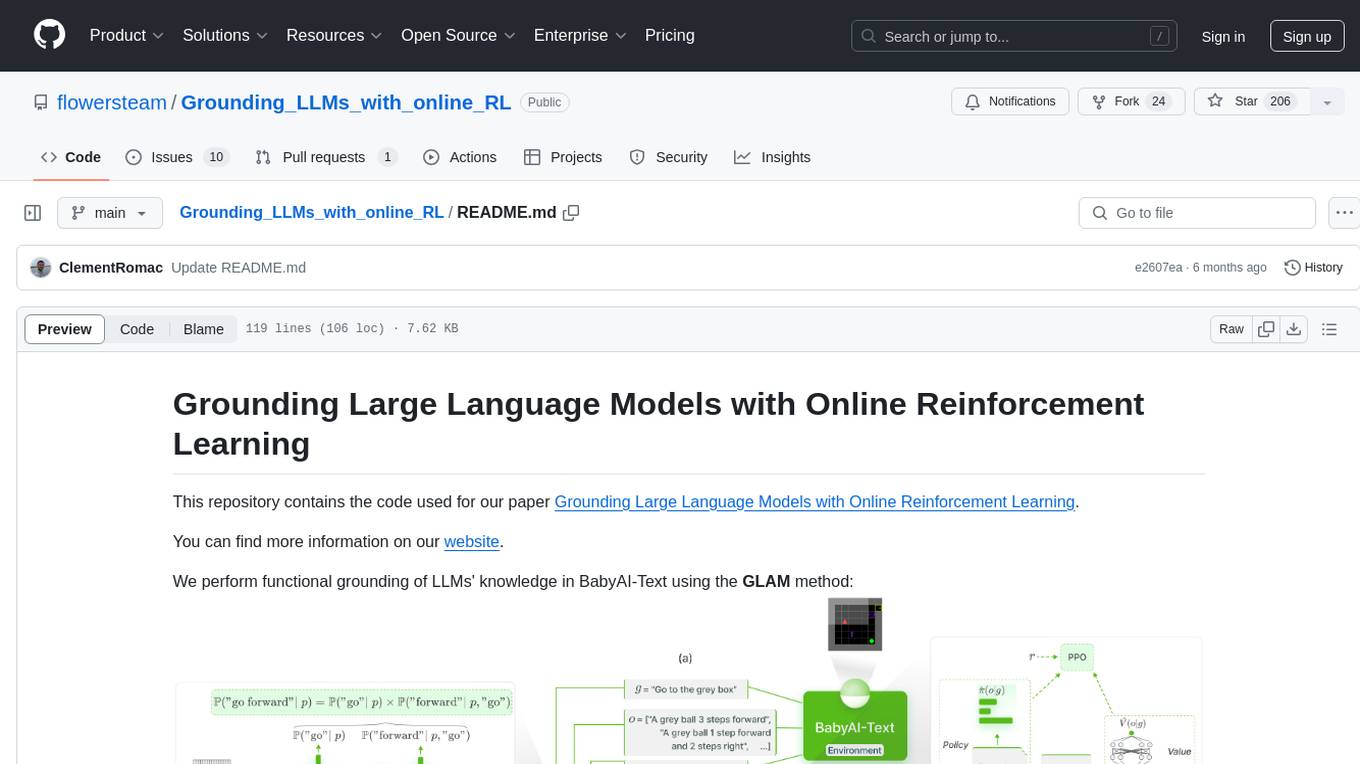
This repository contains code for grounding large language models' knowledge in BabyAI-Text using the GLAM method. It includes the BabyAI-Text environment, code for experiments, and training agents. The repository is structured with folders for the environment, experiments, agents, configurations, SLURM scripts, and training scripts. Installation steps involve creating a conda environment, installing PyTorch, required packages, BabyAI-Text, and Lamorel. The launch process involves using Lamorel with configs and training scripts. Users can train a language model and evaluate performance on test episodes using provided scripts and config entries.
README:
This repository contains the code used for our paper Grounding Large Language Models with Online Reinforcement Learning.
You can find more information on our website.
We perform functional grounding of LLMs' knowledge in BabyAI-Text using the GLAM method:

We release our BabyAI-Text environment along with the code to perform our experiments (both training agents and evaluating their performance). We rely on the Lamorel library to use LLMs.
Our repository is structured as follows:
📦 Grounding_LLMs_with_online_RL
┣ 📂 babyai-text -- our BabyAI-Text environment
┣ 📂 experiments -- code for our experiments
┃ ┣ 📂 agents -- implementation of all our agents
┃ ┃ ┣ 📂 bot -- bot agent leveraging BabyAI's bot
┃ ┃ ┣ 📂 random_agent -- agent playing uniformly random
┃ ┃ ┣ 📂 drrn -- DRRN agent from here
┃ ┃ ┣ 📂 ppo -- agents using PPO
┃ ┃ ┃ ┣ 📜 symbolic_ppo_agent.py -- SymbolicPPO adapted from BabyAI's PPO
┃ ┃ ┃ ┗ 📜 llm_ppo_agent.py -- our LLM agent grounded using PPO
┃ ┣ 📂 configs -- Lamorel configs for our experiments
┃ ┣ 📂 slurm -- utils scripts to launch our experiments on a SLURM cluster
┃ ┣ 📂 campaign -- SLURM scripts used to launch our experiments
┃ ┣ 📜 train_language_agent.py -- train agents using BabyAI-Text (LLMs and DRRN) -> contains our implementation of PPO loss for LLMs as well as additional heads on top of LLMs
┃ ┣ 📜 train_symbolic_ppo.py -- train SymbolicPPO on BabyAI (with BabyAI-Text's tasks)
┃ ┣ 📜 post-training_tests.py -- generalization tests of trained agents
┃ ┣ 📜 test_results.py -- utils to format results
┃ ┗ 📜 clm_behavioral-cloning.py -- code to perform Behavioral Cloning on an LLM using trajectories
- Create conda env
conda create -n dlp python=3.10.8; conda activate dlp
- Install PyTorch
conda install pytorch==1.12.1 torchvision==0.13.1 torchaudio==0.12.1 cudatoolkit=11.3 -c pytorch
- Install packages required by our package
pip install -r requirements.txt
-
Install BabyAI-Text: See installation details in the
babyai-textpackage -
Install Lamorel
git clone https://github.com/flowersteam/lamorel.git; cd lamorel/lamorel; pip install -e .; cd ../..
Please use Lamorel along with our configs. You can find examples of our training scripts in campaign.
To train a Language Model on a BabyAI-Text environment, one must use the train_language_agent.py file.
This script (launched with Lamorel) uses the following config entries:
rl_script_args:
seed: 1
number_envs: 2 # Number of parallel envs to launch (steps will be synchronized, i.e. a step call will return number_envs observations)
num_steps: 1000 # Total number of training steps
max_episode_steps: 3 # Maximum number of steps in a single episode
frames_per_proc: 40 # The number of collected transitions to perform a PPO update will be frames_per_proc*number_envs
discount: 0.99 # Discount factor used in PPO
lr: 1e-6 # Learning rate used to finetune the LLM
beta1: 0.9 # PPO's hyperparameter
beta2: 0.999 # PPO's hyperparameter
gae_lambda: 0.99 # PPO's hyperparameter
entropy_coef: 0.01 # PPO's hyperparameter
value_loss_coef: 0.5 # PPO's hyperparameter
max_grad_norm: 0.5 # Maximum grad norm when updating the LLM's parameters
adam_eps: 1e-5 # Adam's hyperparameter
clip_eps: 0.2 # Epsilon used in PPO's losses clipping
epochs: 4 # Number of PPO epochs performed on each set of collected trajectories
batch_size: 16 # Minibatch size
action_space: ["turn_left","turn_right","go_forward","pick_up","drop","toggle"] # Possible actions for the agent
saving_path_logs: ??? # Where to store logs
name_experiment: 'llm_mtrl' # Useful for logging
name_model: 'T5small' # Useful for logging
saving_path_model: ??? # Where to store the finetuned model
name_environment: 'BabyAI-MixedTestLocal-v0' # BabiAI-Text's environment
load_embedding: true # Whether trained embedding layers should be loaded (useful when lm_args.pretrained=False). Setting both this and use_action_heads to True (lm_args.pretrained=False) creates our NPAE agent.
use_action_heads: false # Whether action heads should be used instead of scoring. Setting both this and use_action_heads to True (lm_args.pretrained=False) creates our NPAE agent.
template_test: 1 # Which prompt template to use to log evolution of action's probability (Section C of our paper). Choices or [1, 2].
nbr_obs: 3 # Number of past observation used in the promptFor the config entries related to the Language Model itself, please see Lamorel.
To evaluate the performance of an agent (e.g. a trained LLM, BabyAI's bot...) on test tasks, use post-training_tests.py and set the following config entries:
rl_script_args:
seed: 1
number_envs: 2 # Number of parallel envs to launch (steps will be synchronized, i.e. a step call will return number_envs observations)
max_episode_steps: 3 # Maximum number of steps in a single episode
action_space: ["turn_left","turn_right","go_forward","pick_up","drop","toggle"] # Possible actions for the agent
saving_path_logs: ??? # Where to store logs
name_experiment: 'llm_mtrl' # Useful for logging
name_model: 'T5small' # Useful for logging
saving_path_model: ??? # Where to store the finetuned model
name_environment: 'BabyAI-MixedTestLocal-v0' # BabiAI-Text's environment
load_embedding: true # Whether trained embedding layers should be loaded (useful when lm_args.pretrained=False). Setting both this and use_action_heads to True (lm_args.pretrained=False) creates our NPAE agent.
use_action_heads: false # Whether action heads should be used instead of scoring. Setting both this and use_action_heads to True (lm_args.pretrained=False) creates our NPAE agent.
nbr_obs: 3 # Number of past observation used in the prompt
number_episodes: 10 # Number of test episodes
language: 'english' # Useful to perform the French experiment (Section H4)
zero_shot: true # Whether the zero-shot LLM (i.e. without finetuning should be used)
modified_action_space: false # Whether a modified action space (e.g. different from the one seen during training) should be used
new_action_space: #["rotate_left","rotate_right","move_ahead","take","release","switch"] # Modified action space
im_learning: false # Whether a LLM produced with Behavioral Cloning should be used
im_path: "" # Path to the LLM learned with Behavioral Cloning
bot: false # Whether the BabyAI's bot agent should be usedFor Tasks:
Click tags to check more tools for each tasksFor Jobs:
Alternative AI tools for Grounding_LLMs_with_online_RL
Similar Open Source Tools

Grounding_LLMs_with_online_RL
This repository contains code for grounding large language models' knowledge in BabyAI-Text using the GLAM method. It includes the BabyAI-Text environment, code for experiments, and training agents. The repository is structured with folders for the environment, experiments, agents, configurations, SLURM scripts, and training scripts. Installation steps involve creating a conda environment, installing PyTorch, required packages, BabyAI-Text, and Lamorel. The launch process involves using Lamorel with configs and training scripts. Users can train a language model and evaluate performance on test episodes using provided scripts and config entries.
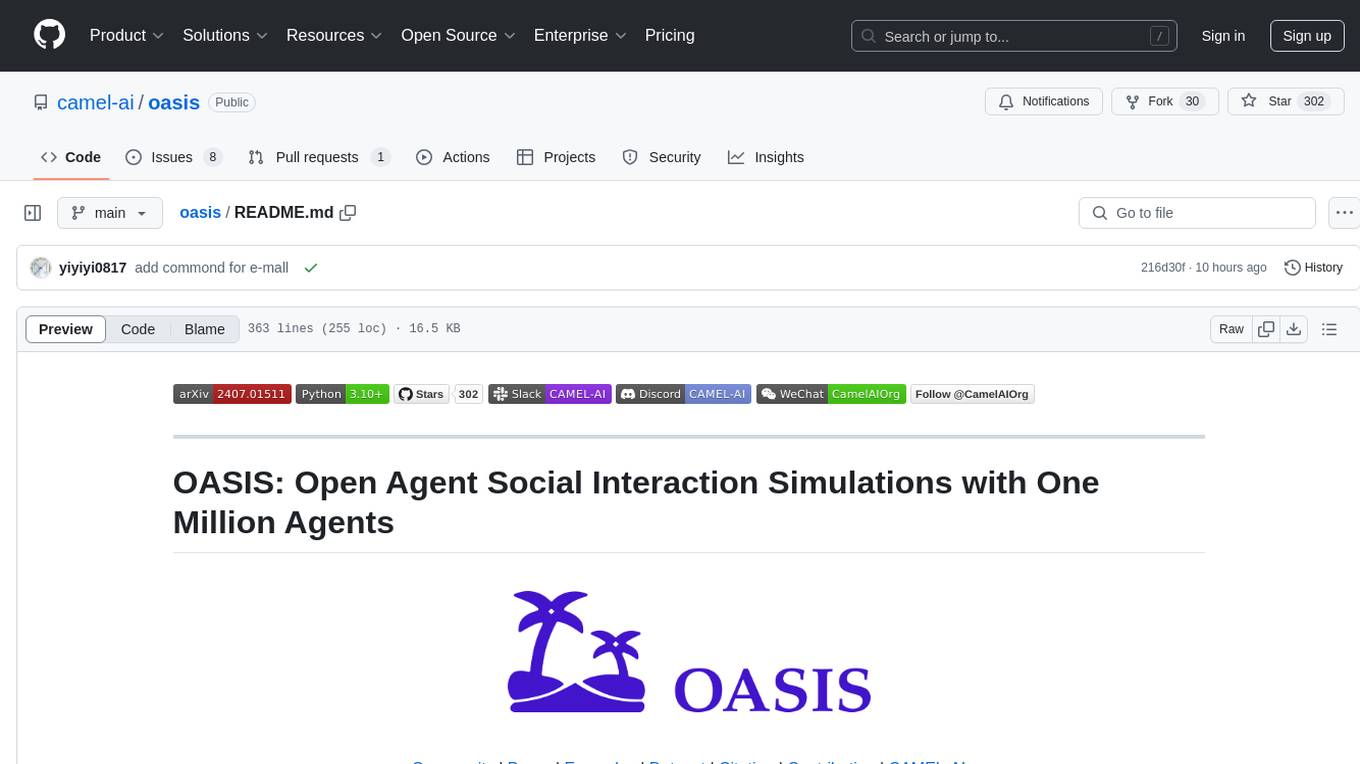
oasis
OASIS is a scalable, open-source social media simulator that integrates large language models with rule-based agents to realistically mimic the behavior of up to one million users on platforms like Twitter and Reddit. It facilitates the study of complex social phenomena such as information spread, group polarization, and herd behavior, offering a versatile tool for exploring diverse social dynamics and user interactions in digital environments. With features like scalability, dynamic environments, diverse action spaces, and integrated recommendation systems, OASIS provides a comprehensive platform for simulating social media interactions at a large scale.
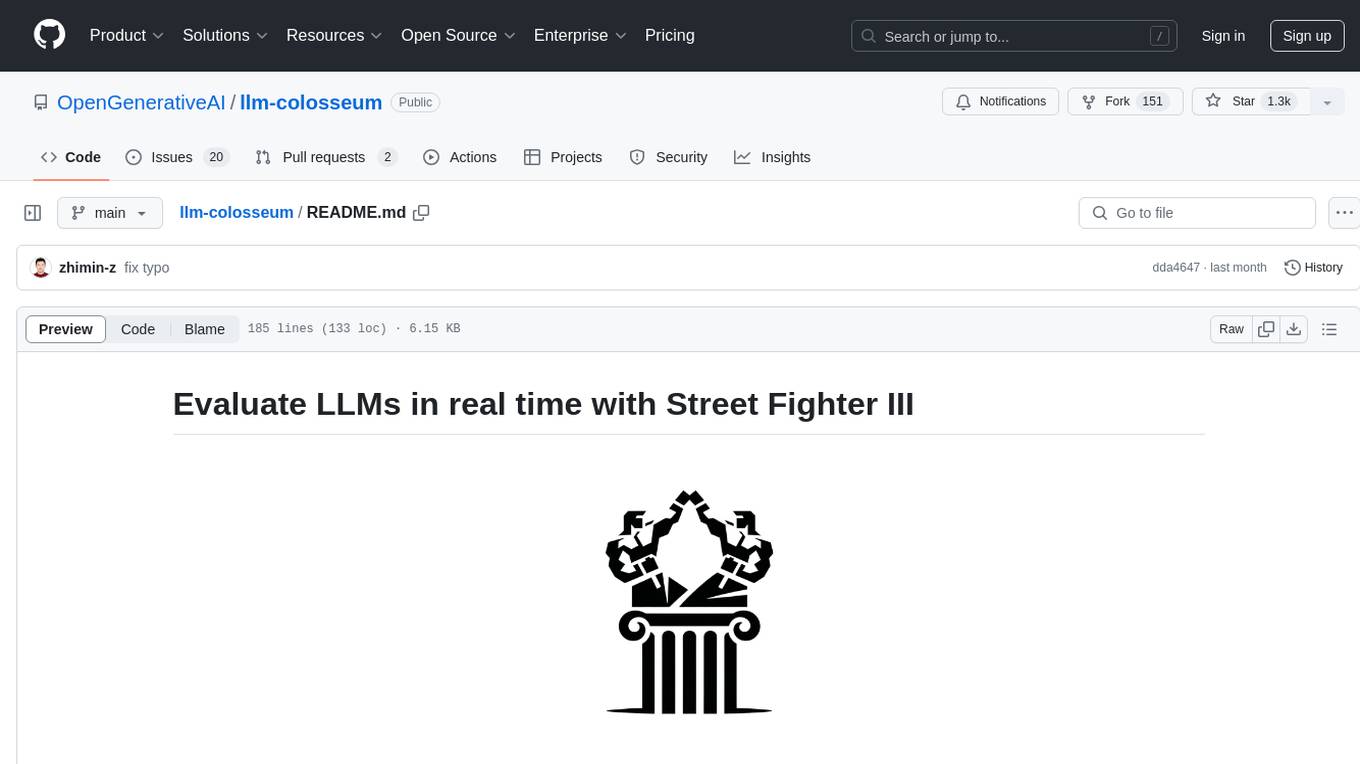
llm-colosseum
llm-colosseum is a tool designed to evaluate Language Model Models (LLMs) in real-time by making them fight each other in Street Fighter III. The tool assesses LLMs based on speed, strategic thinking, adaptability, out-of-the-box thinking, and resilience. It provides a benchmark for LLMs to understand their environment and take context-based actions. Users can analyze the performance of different LLMs through ELO rankings and win rate matrices. The tool allows users to run experiments, test different LLM models, and customize prompts for LLM interactions. It offers installation instructions, test mode options, logging configurations, and the ability to run the tool with local models. Users can also contribute their own LLM models for evaluation and ranking.
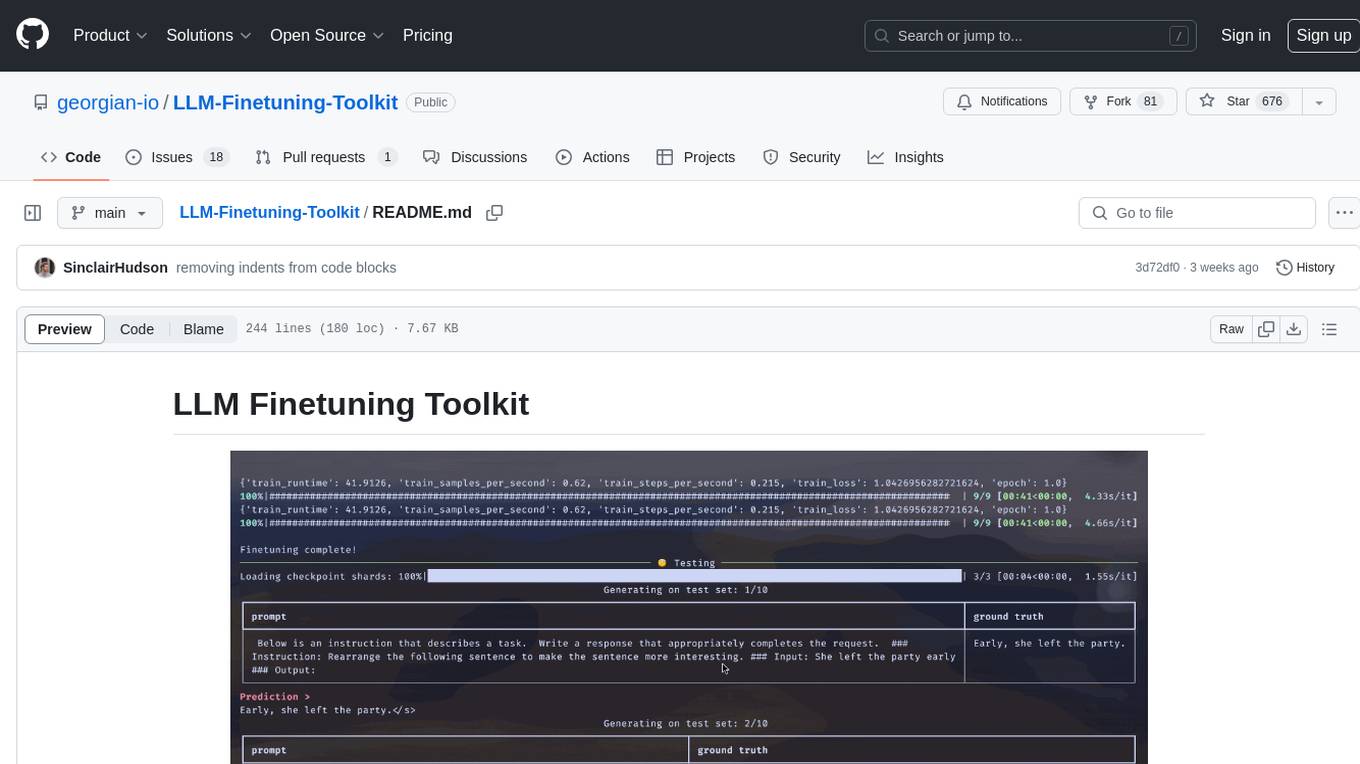
LLM-Finetuning-Toolkit
LLM Finetuning toolkit is a config-based CLI tool for launching a series of LLM fine-tuning experiments on your data and gathering their results. It allows users to control all elements of a typical experimentation pipeline - prompts, open-source LLMs, optimization strategy, and LLM testing - through a single YAML configuration file. The toolkit supports basic, intermediate, and advanced usage scenarios, enabling users to run custom experiments, conduct ablation studies, and automate fine-tuning workflows. It provides features for data ingestion, model definition, training, inference, quality assurance, and artifact outputs, making it a comprehensive tool for fine-tuning large language models.
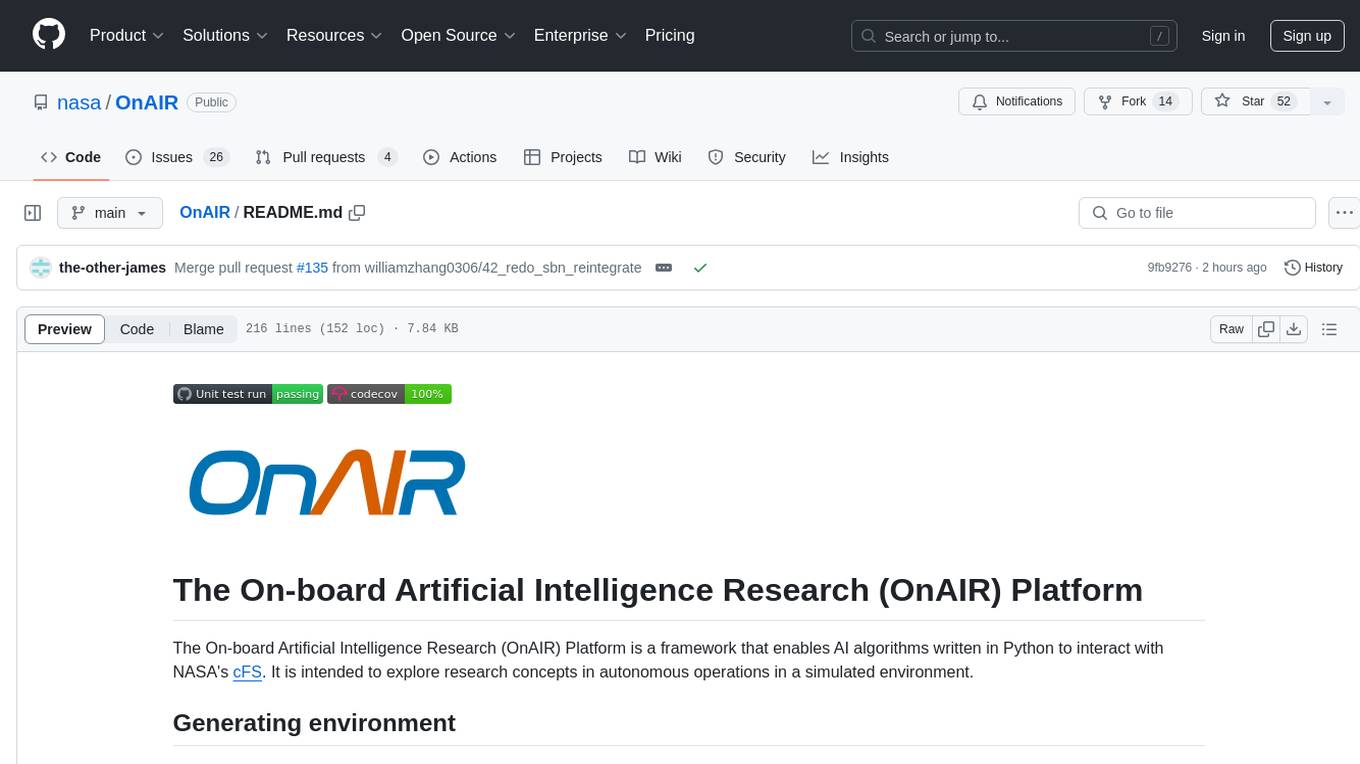
OnAIR
The On-board Artificial Intelligence Research (OnAIR) Platform is a framework that enables AI algorithms written in Python to interact with NASA's cFS. It is intended to explore research concepts in autonomous operations in a simulated environment. The platform provides tools for generating environments, handling telemetry data through Redis, running unit tests, and contributing to the repository. Users can set up a conda environment, configure telemetry and Redis examples, run simulations, and conduct unit tests to ensure the functionality of their AI algorithms. The platform also includes guidelines for licensing, copyright, and contributions to the repository.
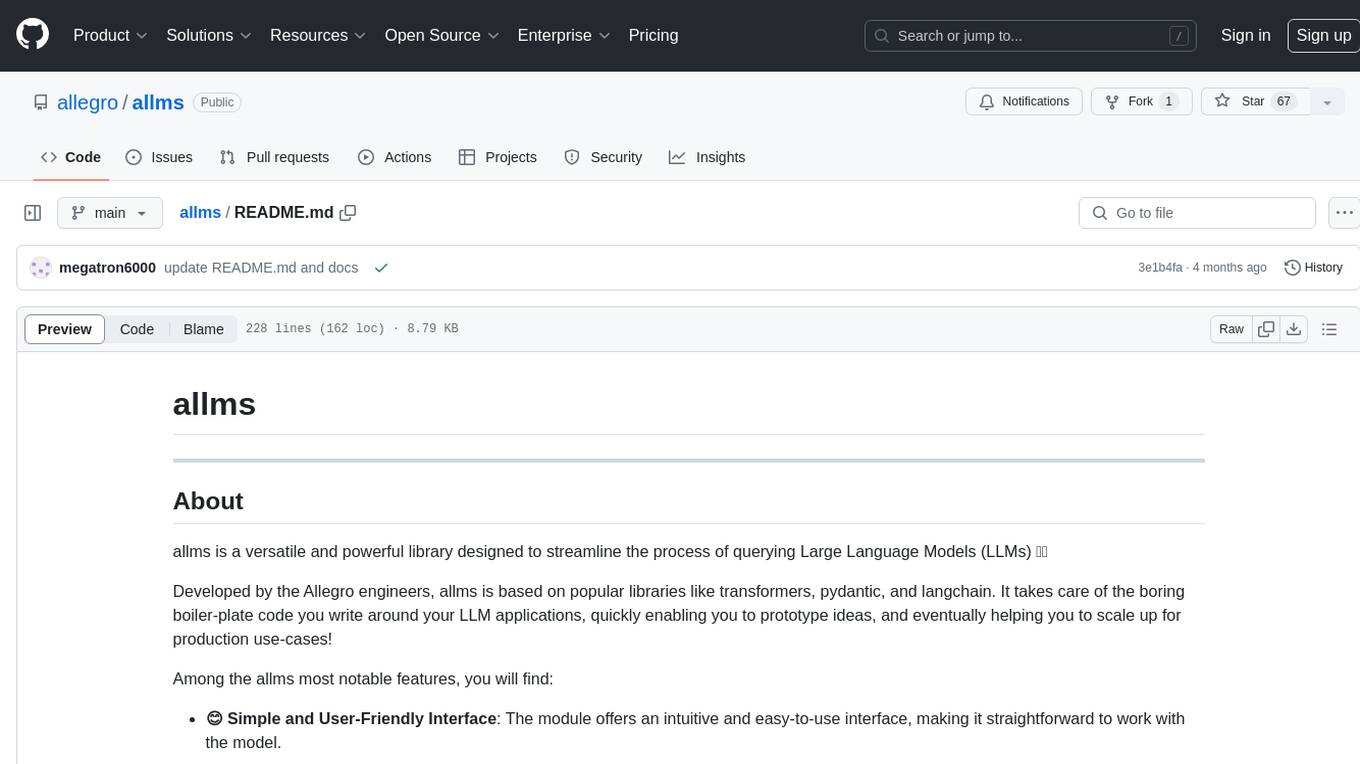
allms
allms is a versatile and powerful library designed to streamline the process of querying Large Language Models (LLMs). Developed by Allegro engineers, it simplifies working with LLM applications by providing a user-friendly interface, asynchronous querying, automatic retrying mechanism, error handling, and output parsing. It supports various LLM families hosted on different platforms like OpenAI, Google, Azure, and GCP. The library offers features for configuring endpoint credentials, batch querying with symbolic variables, and forcing structured output format. It also provides documentation, quickstart guides, and instructions for local development, testing, updating documentation, and making new releases.
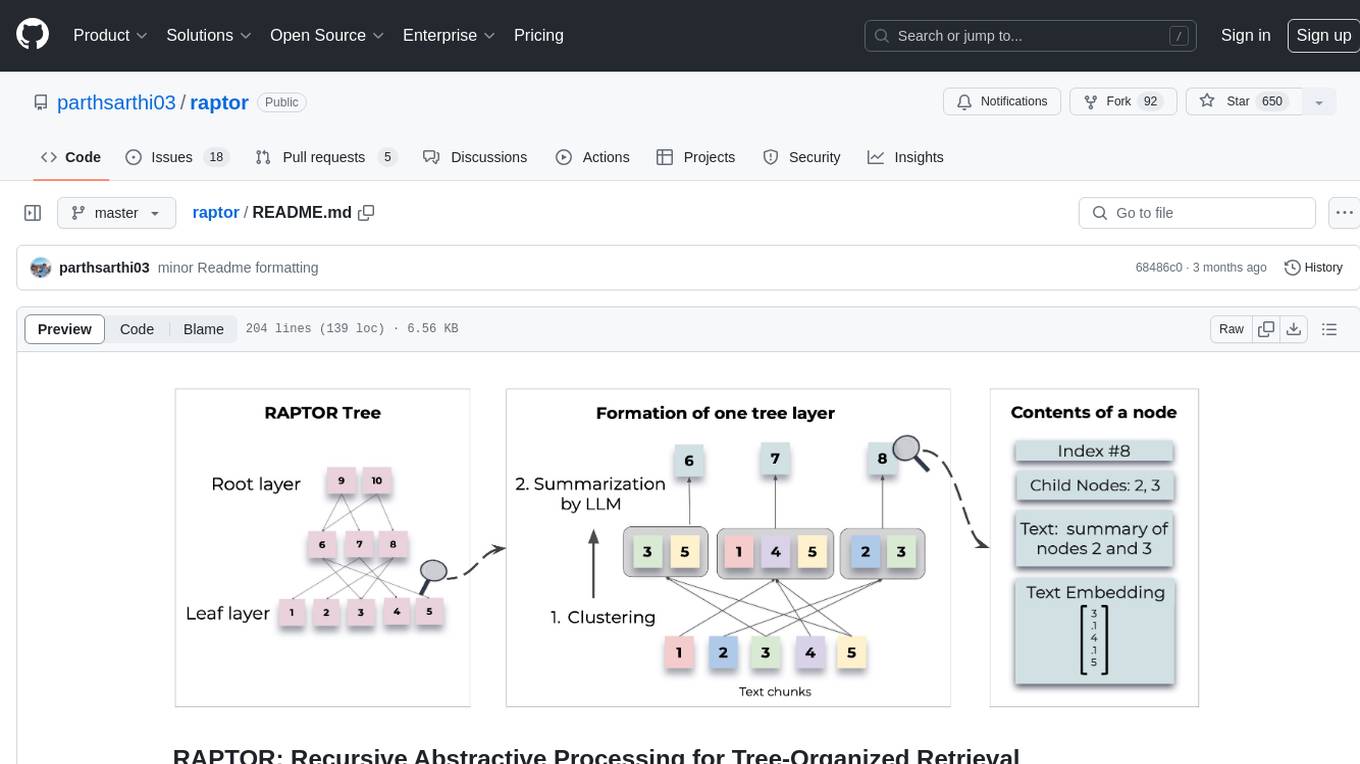
raptor
RAPTOR introduces a novel approach to retrieval-augmented language models by constructing a recursive tree structure from documents. This allows for more efficient and context-aware information retrieval across large texts, addressing common limitations in traditional language models. Users can add documents to the tree, answer questions based on indexed documents, save and load the tree, and extend RAPTOR with custom summarization, question-answering, and embedding models. The tool is designed to be flexible and customizable for various NLP tasks.
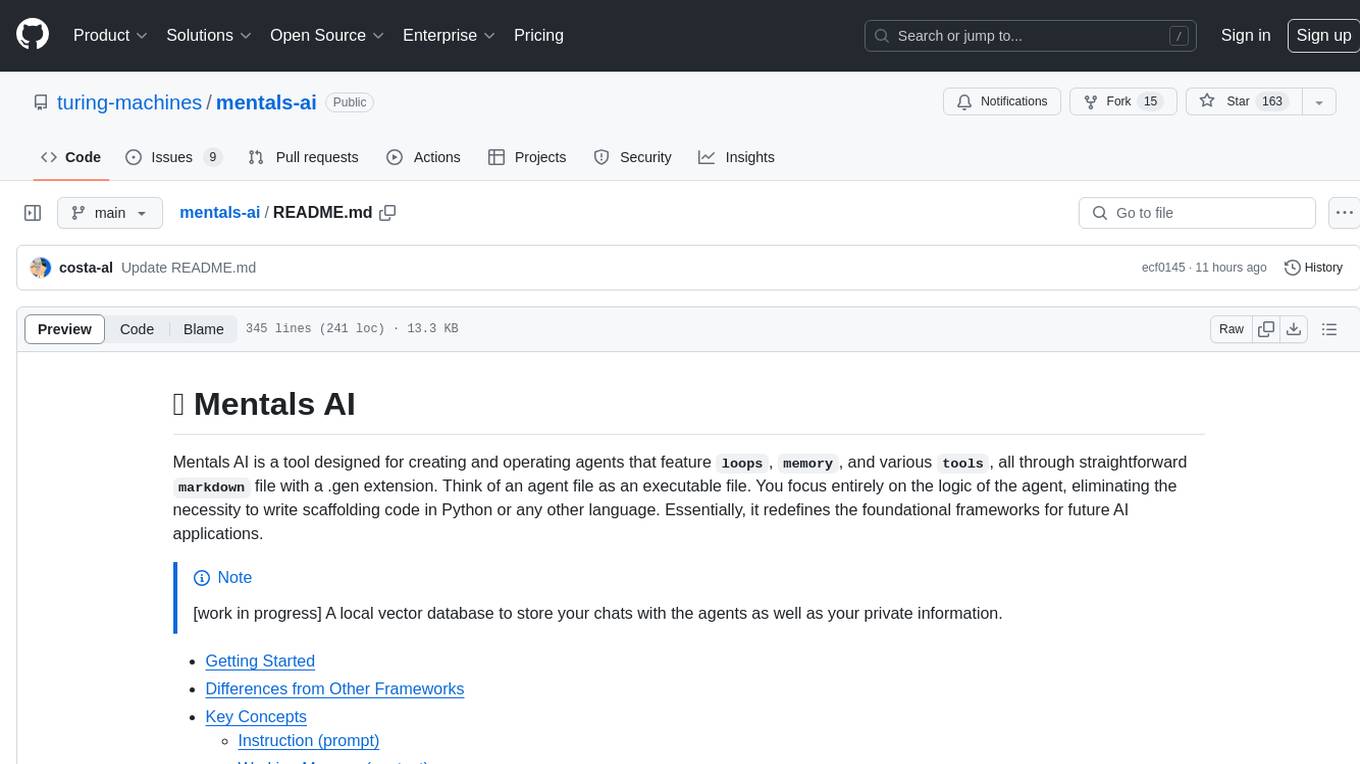
mentals-ai
Mentals AI is a tool designed for creating and operating agents that feature loops, memory, and various tools, all through straightforward markdown syntax. This tool enables you to concentrate solely on the agent’s logic, eliminating the necessity to compose underlying code in Python or any other language. It redefines the foundational frameworks for future AI applications by allowing the creation of agents with recursive decision-making processes, integration of reasoning frameworks, and control flow expressed in natural language. Key concepts include instructions with prompts and references, working memory for context, short-term memory for storing intermediate results, and control flow from strings to algorithms. The tool provides a set of native tools for message output, user input, file handling, Python interpreter, Bash commands, and short-term memory. The roadmap includes features like a web UI, vector database tools, agent's experience, and tools for image generation and browsing. The idea behind Mentals AI originated from studies on psychoanalysis executive functions and aims to integrate 'System 1' (cognitive executor) with 'System 2' (central executive) to create more sophisticated agents.
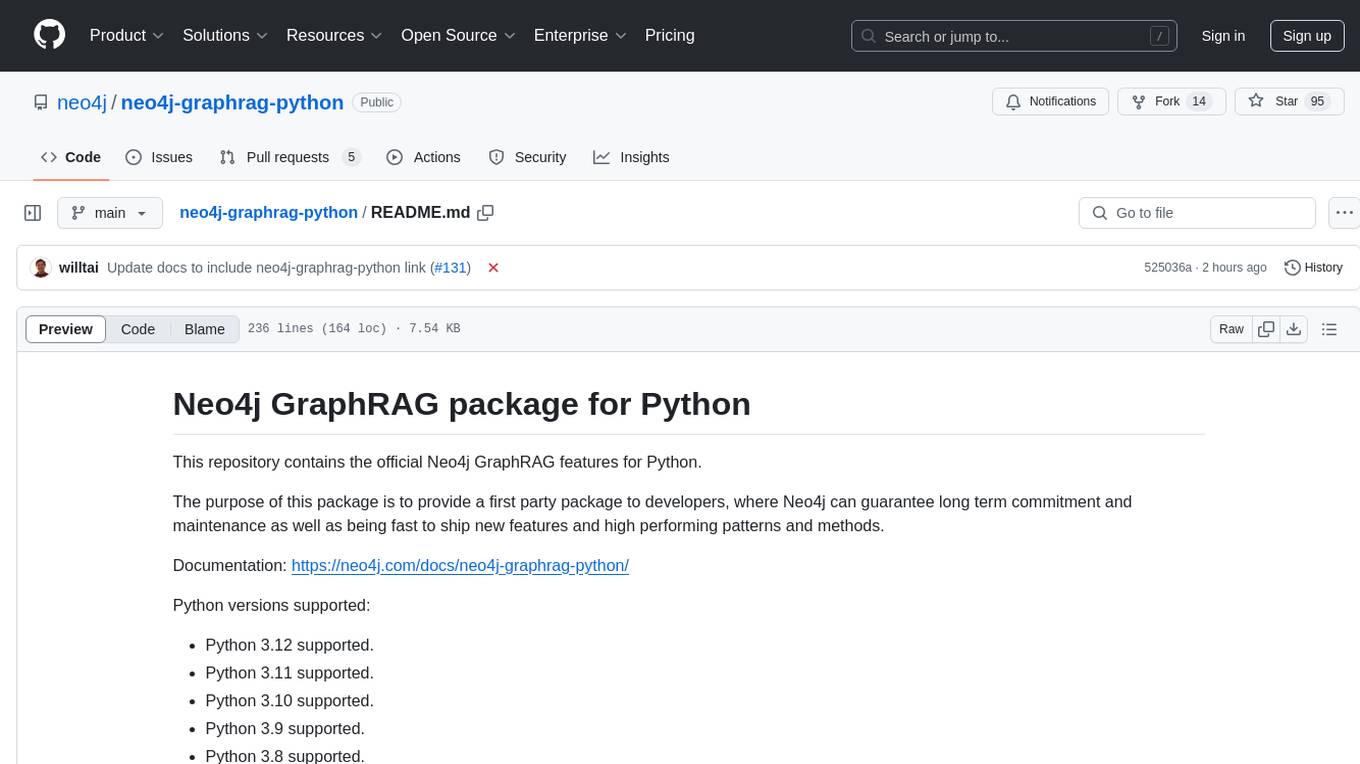
neo4j-graphrag-python
The Neo4j GraphRAG package for Python is an official repository that provides features for creating and managing vector indexes in Neo4j databases. It aims to offer developers a reliable package with long-term commitment, maintenance, and fast feature updates. The package supports various Python versions and includes functionalities for creating vector indexes, populating them, and performing similarity searches. It also provides guidelines for installation, examples, and development processes such as installing dependencies, making changes, and running tests.
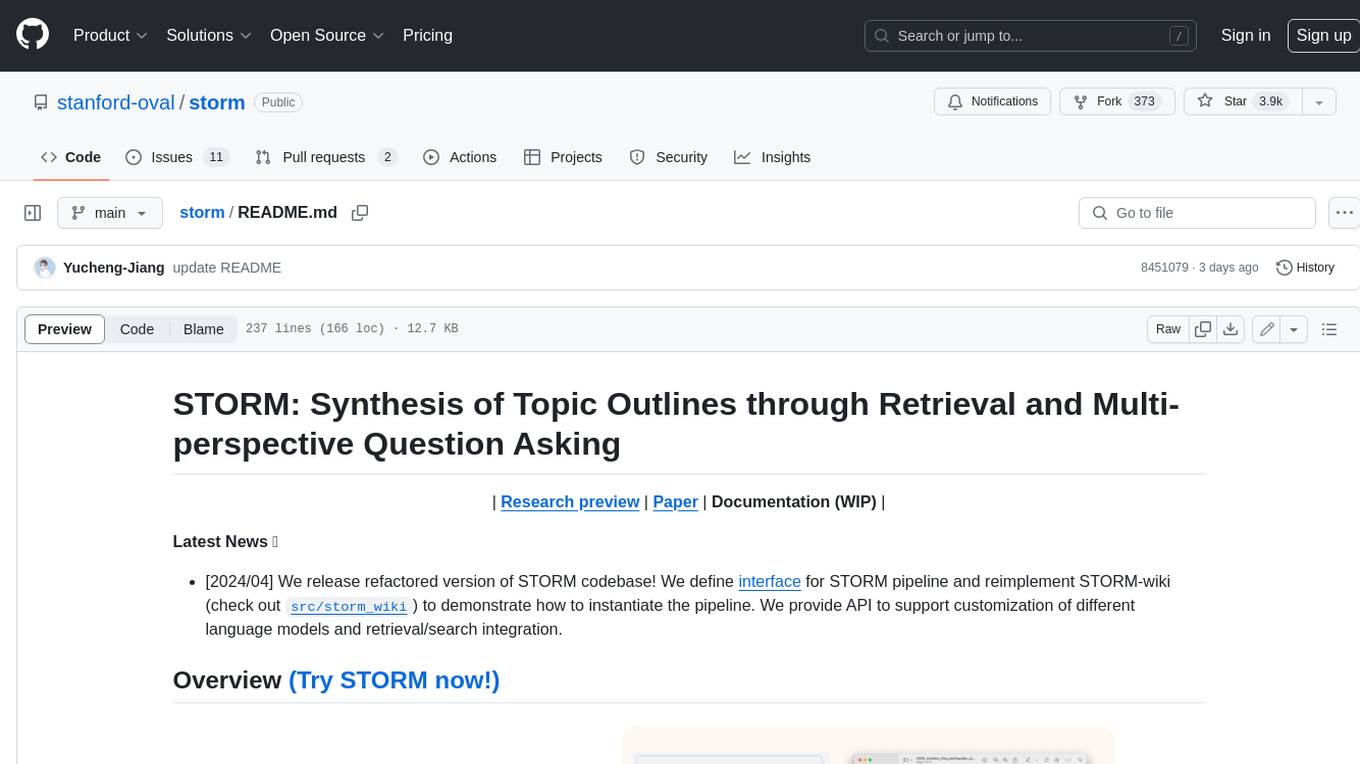
storm
STORM is a LLM system that writes Wikipedia-like articles from scratch based on Internet search. While the system cannot produce publication-ready articles that often require a significant number of edits, experienced Wikipedia editors have found it helpful in their pre-writing stage. **Try out our [live research preview](https://storm.genie.stanford.edu/) to see how STORM can help your knowledge exploration journey and please provide feedback to help us improve the system 🙏!**
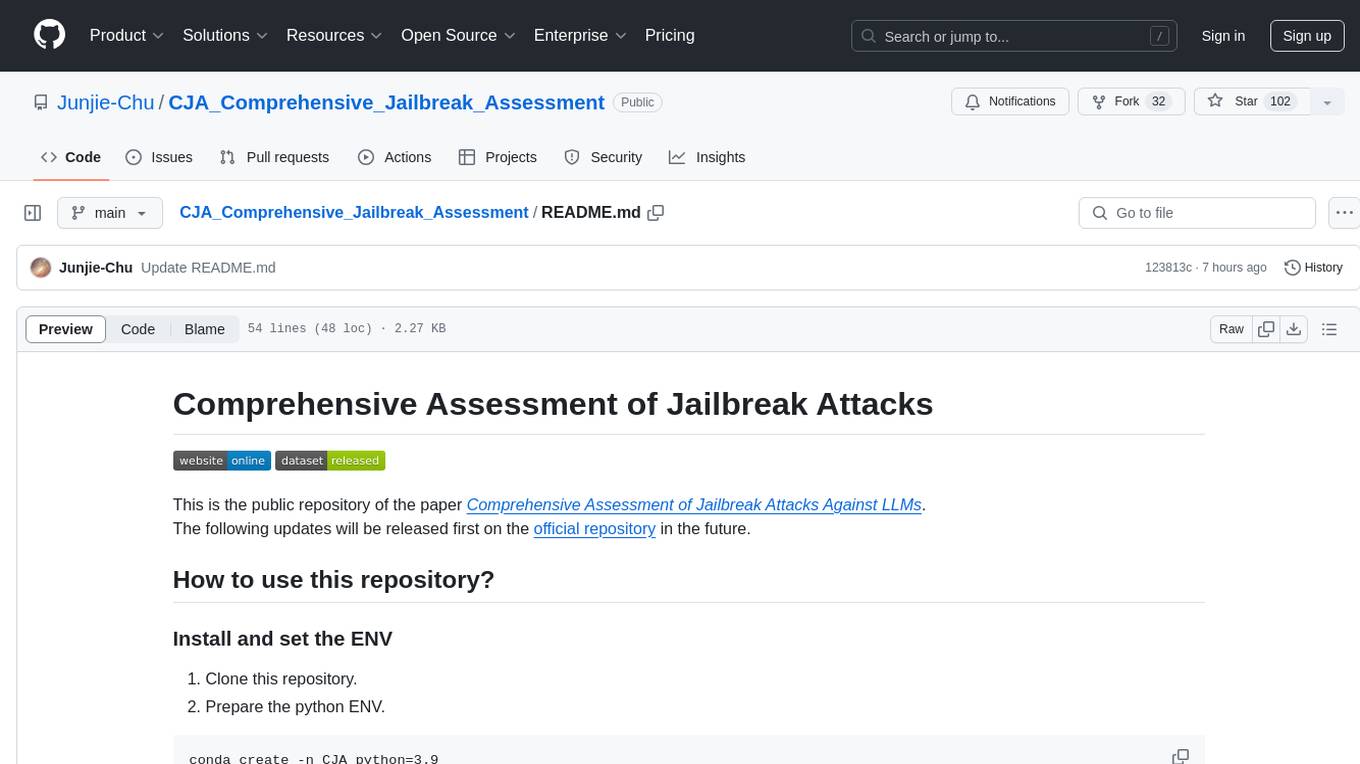
CJA_Comprehensive_Jailbreak_Assessment
This public repository contains the paper 'Comprehensive Assessment of Jailbreak Attacks Against LLMs'. It provides a labeling method to label results using Python and offers the opportunity to submit evaluation results to the leaderboard. Full codes will be released after the paper is accepted.
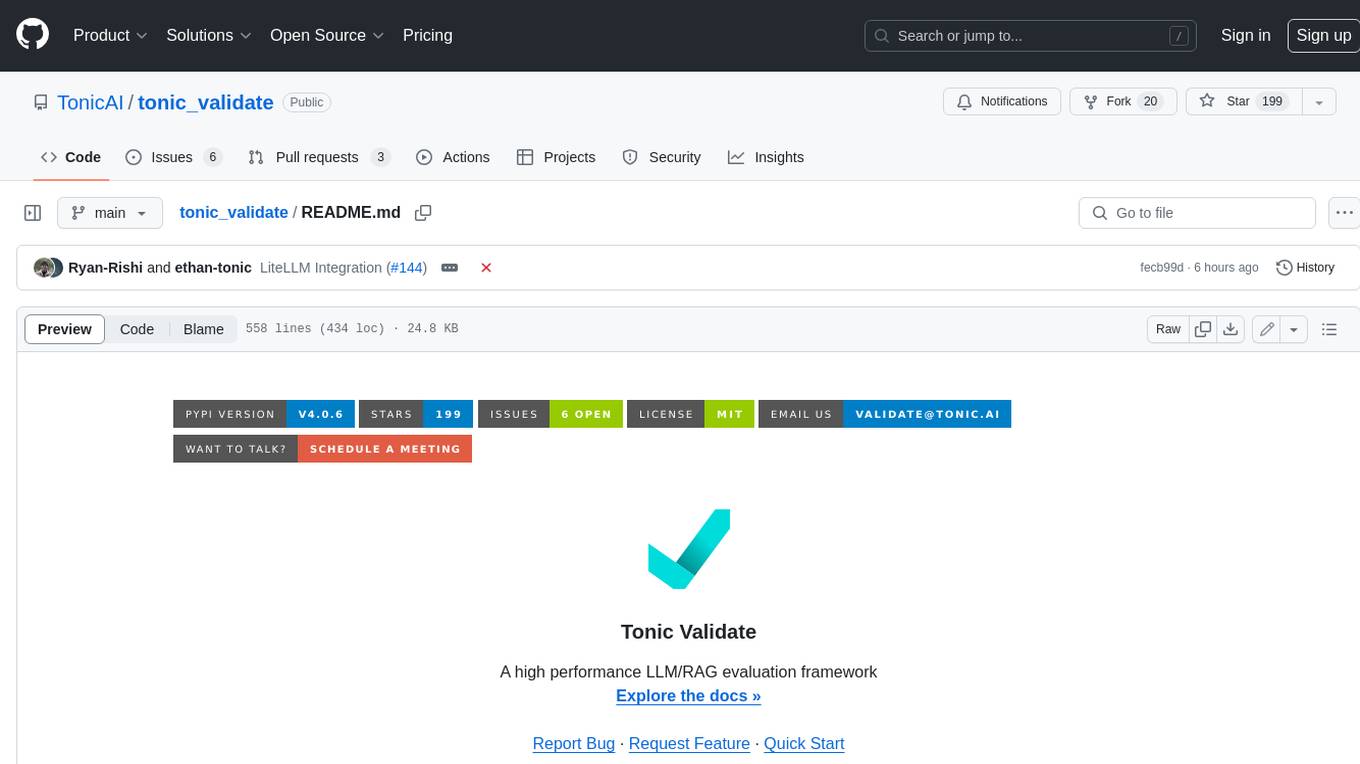
tonic_validate
Tonic Validate is a framework for the evaluation of LLM outputs, such as Retrieval Augmented Generation (RAG) pipelines. Validate makes it easy to evaluate, track, and monitor your LLM and RAG applications. Validate allows you to evaluate your LLM outputs through the use of our provided metrics which measure everything from answer correctness to LLM hallucination. Additionally, Validate has an optional UI to visualize your evaluation results for easy tracking and monitoring.
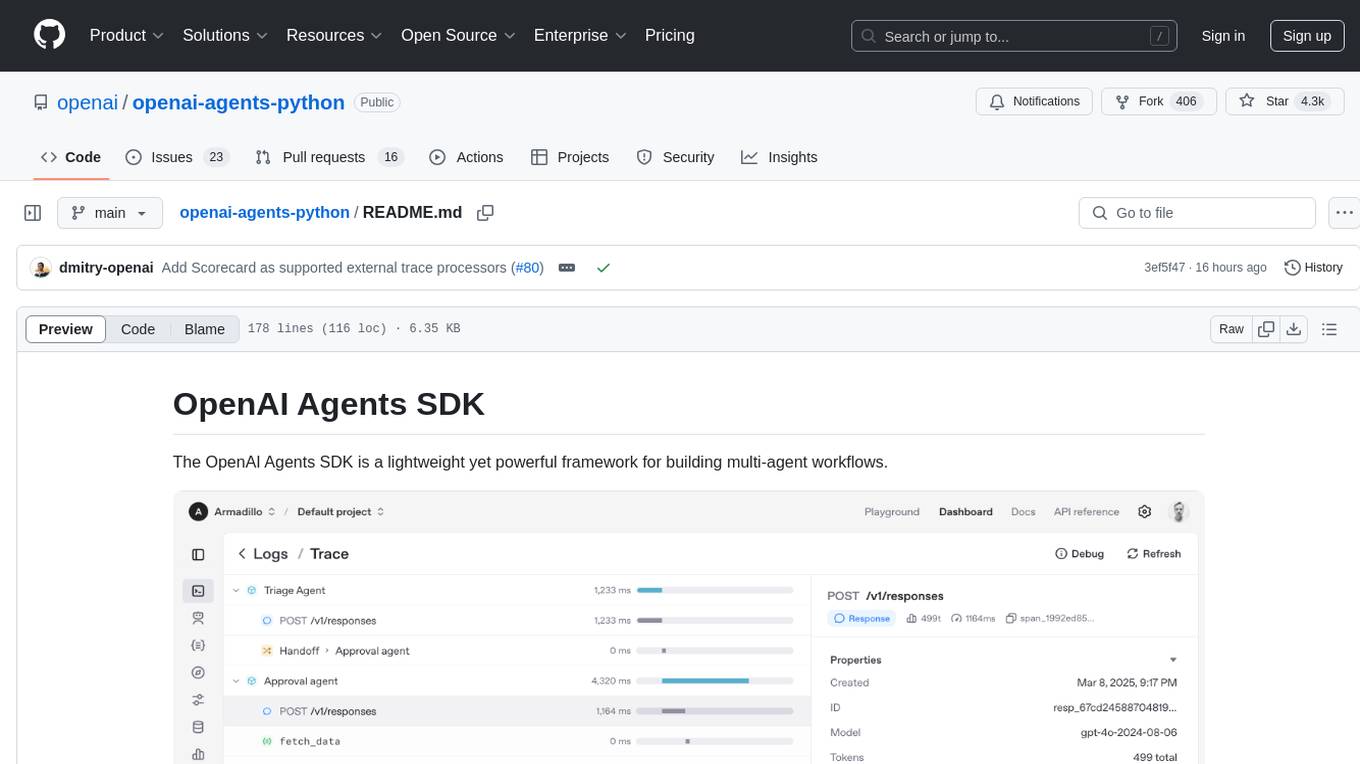
openai-agents-python
The OpenAI Agents SDK is a lightweight framework for building multi-agent workflows. It includes concepts like Agents, Handoffs, Guardrails, and Tracing to facilitate the creation and management of agents. The SDK is compatible with any model providers supporting the OpenAI Chat Completions API format. It offers flexibility in modeling various LLM workflows and provides automatic tracing for easy tracking and debugging of agent behavior. The SDK is designed for developers to create deterministic flows, iterative loops, and more complex workflows.
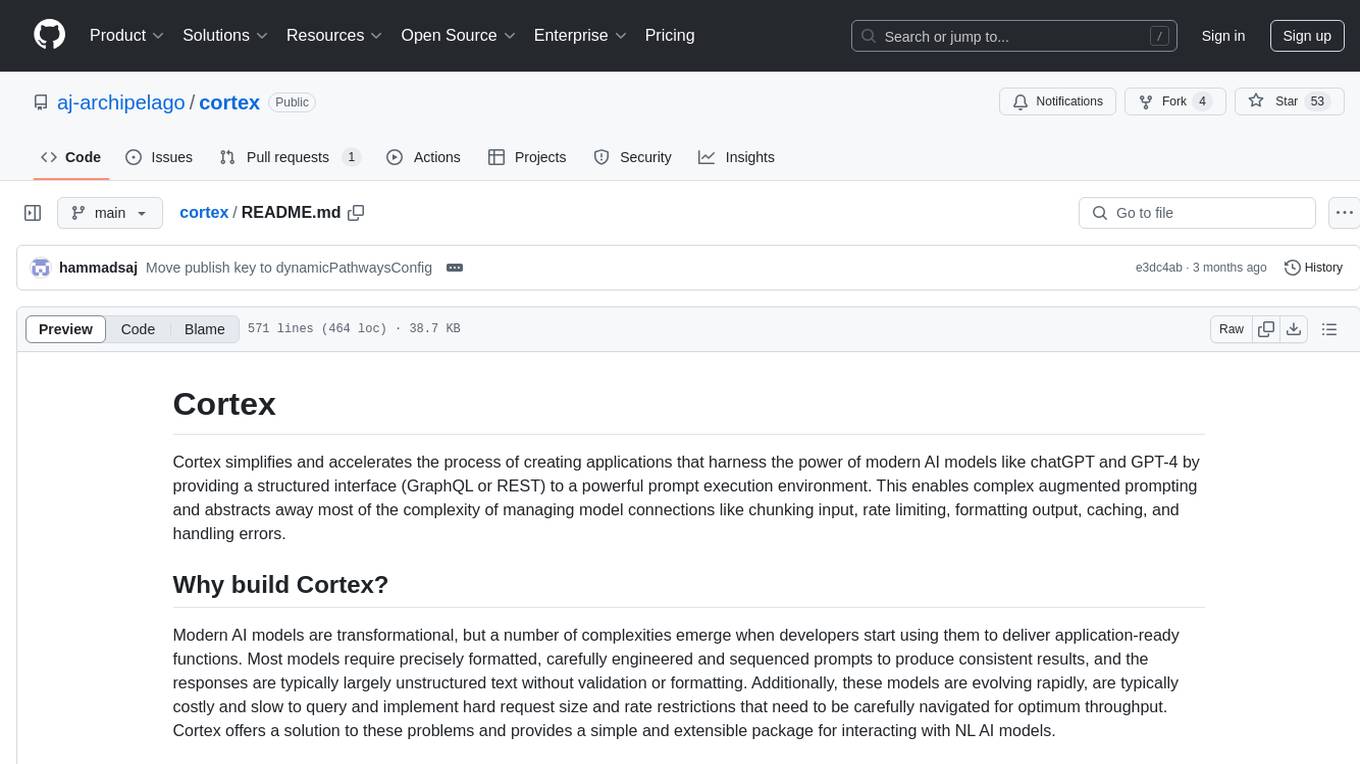
cortex
Cortex is a tool that simplifies and accelerates the process of creating applications utilizing modern AI models like chatGPT and GPT-4. It provides a structured interface (GraphQL or REST) to a prompt execution environment, enabling complex augmented prompting and abstracting away model connection complexities like input chunking, rate limiting, output formatting, caching, and error handling. Cortex offers a solution to challenges faced when using AI models, providing a simple package for interacting with NL AI models.
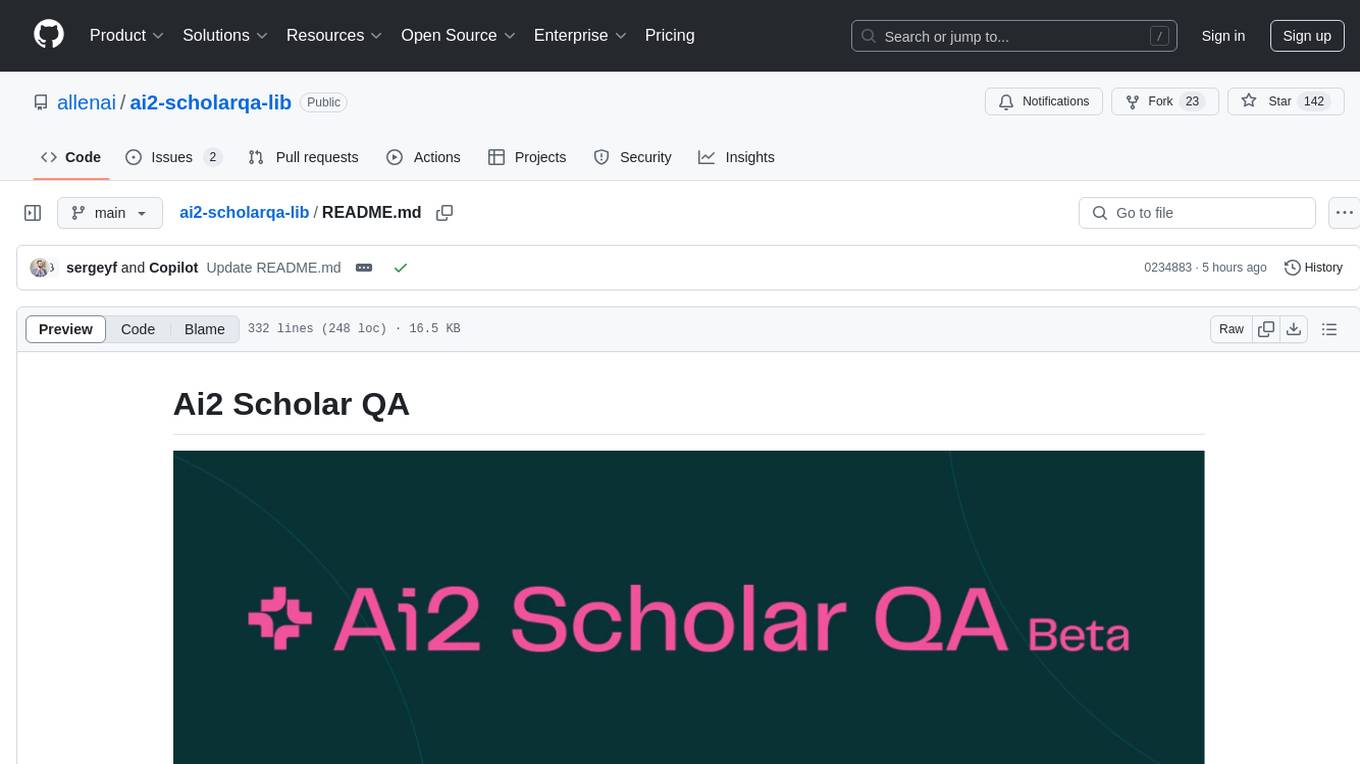
ai2-scholarqa-lib
Ai2 Scholar QA is a system for answering scientific queries and literature review by gathering evidence from multiple documents across a corpus and synthesizing an organized report with evidence for each claim. It consists of a retrieval component and a three-step generator pipeline. The retrieval component fetches relevant evidence passages using the Semantic Scholar public API and reranks them. The generator pipeline includes quote extraction, planning and clustering, and summary generation. The system is powered by the ScholarQA class, which includes components like PaperFinder and MultiStepQAPipeline. It requires environment variables for Semantic Scholar API and LLMs, and can be run as local docker containers or embedded into another application as a Python package.
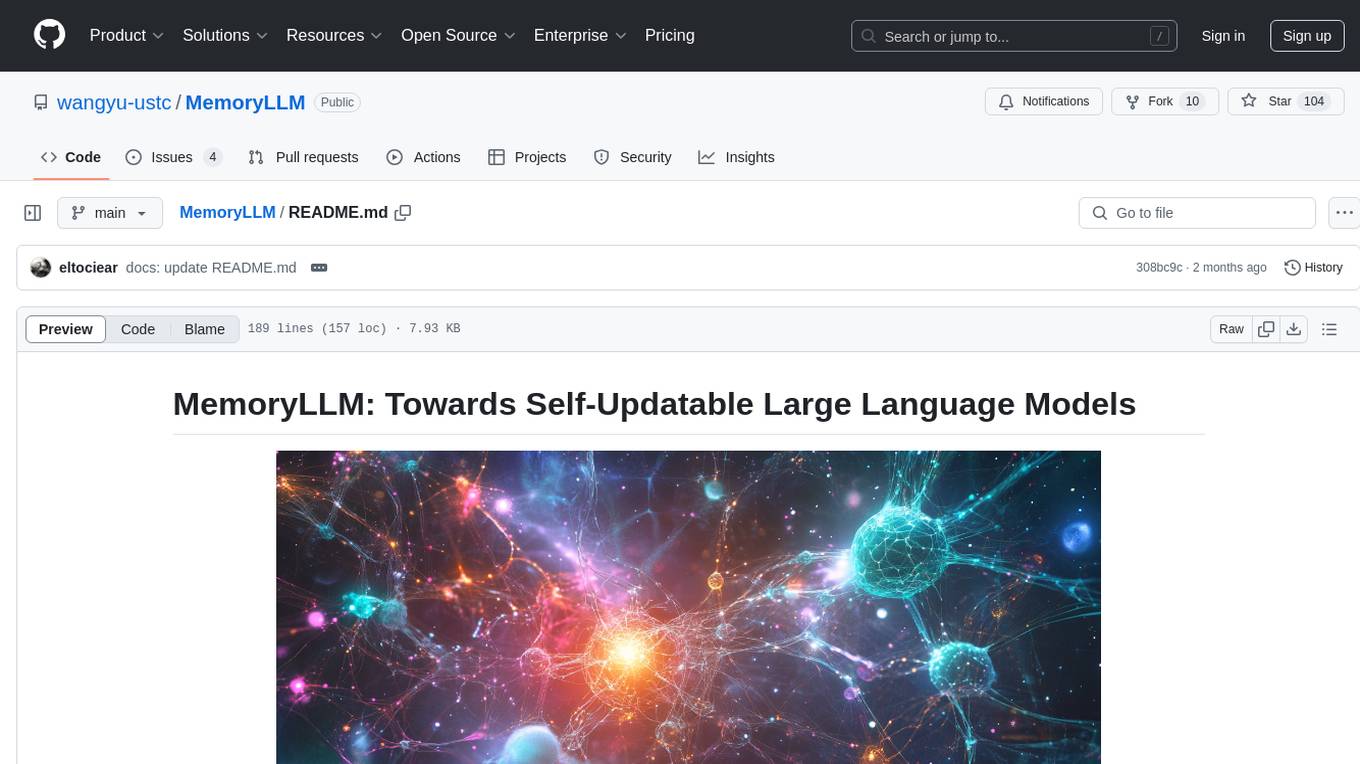
MemoryLLM
MemoryLLM is a large language model designed for self-updating capabilities. It offers pretrained models with different memory capacities and features, such as chat models. The repository provides training code, evaluation scripts, and datasets for custom experiments. MemoryLLM aims to enhance knowledge retention and performance on various natural language processing tasks.
For similar tasks
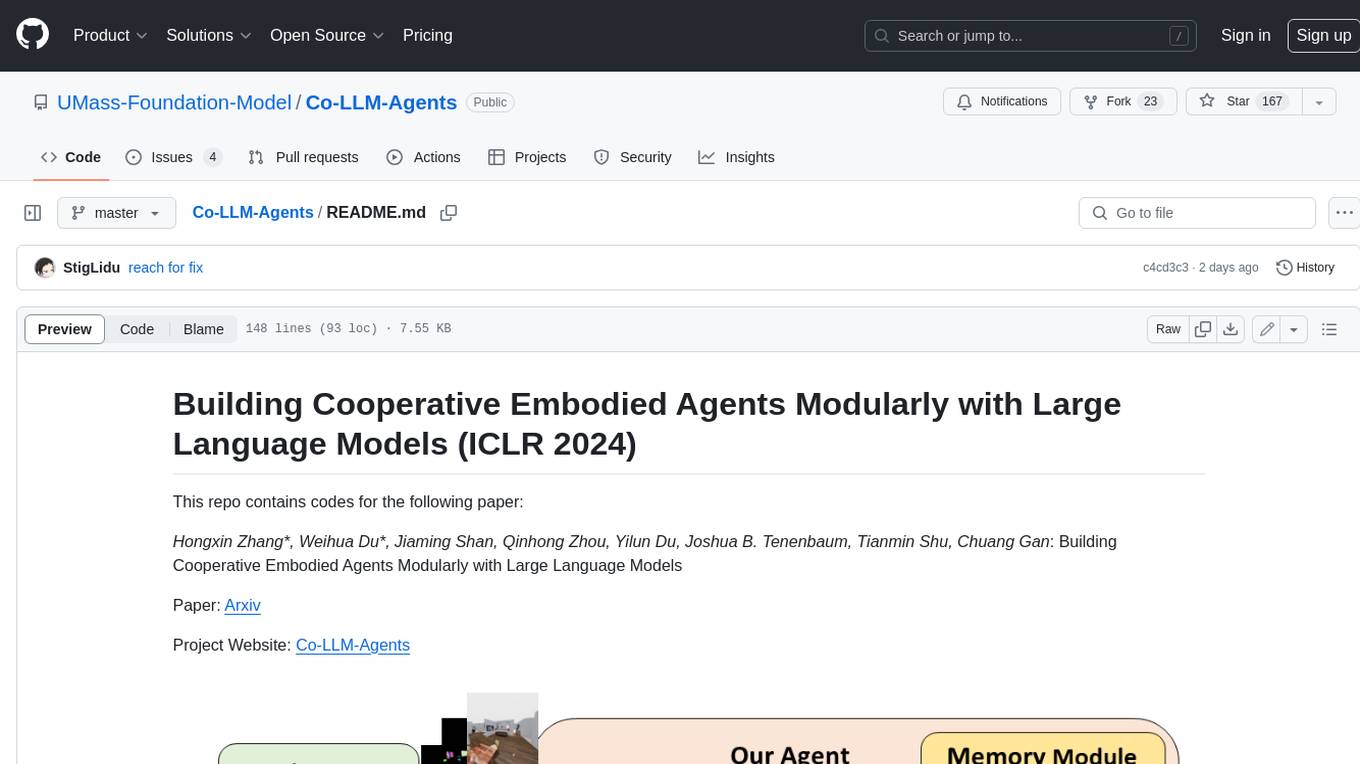
Co-LLM-Agents
This repository contains code for building cooperative embodied agents modularly with large language models. The agents are trained to perform tasks in two different environments: ThreeDWorld Multi-Agent Transport (TDW-MAT) and Communicative Watch-And-Help (C-WAH). TDW-MAT is a multi-agent environment where agents must transport objects to a goal position using containers. C-WAH is an extension of the Watch-And-Help challenge, which enables agents to send messages to each other. The code in this repository can be used to train agents to perform tasks in both of these environments.
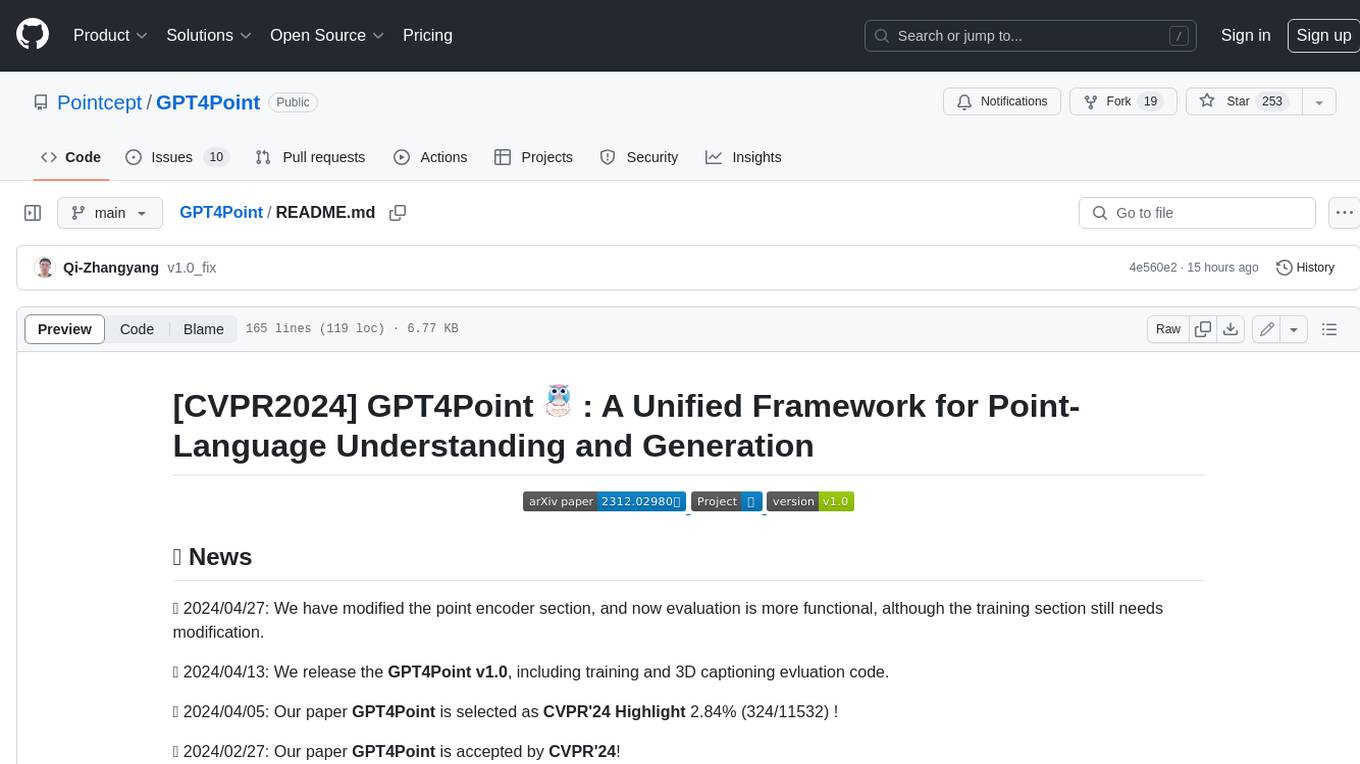
GPT4Point
GPT4Point is a unified framework for point-language understanding and generation. It aligns 3D point clouds with language, providing a comprehensive solution for tasks such as 3D captioning and controlled 3D generation. The project includes an automated point-language dataset annotation engine, a novel object-level point cloud benchmark, and a 3D multi-modality model. Users can train and evaluate models using the provided code and datasets, with a focus on improving models' understanding capabilities and facilitating the generation of 3D objects.
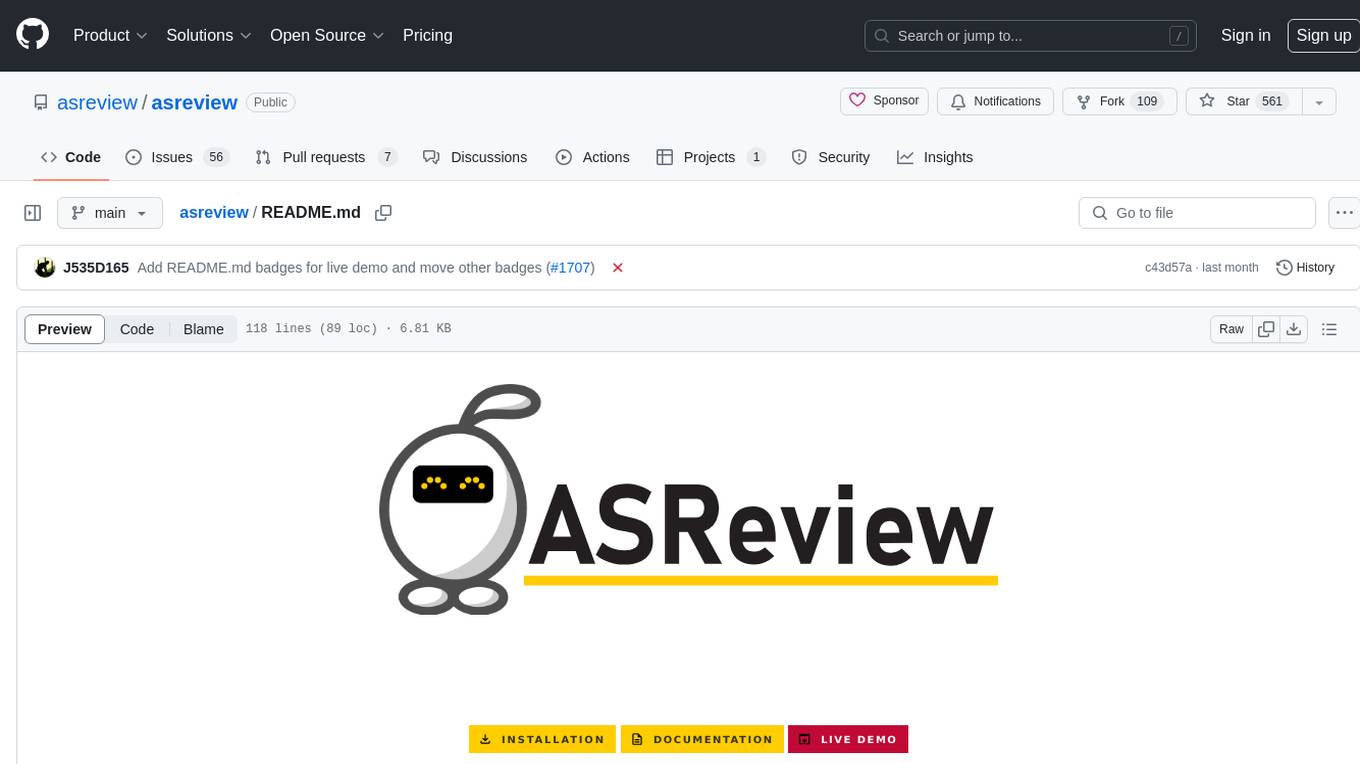
asreview
The ASReview project implements active learning for systematic reviews, utilizing AI-aided pipelines to assist in finding relevant texts for search tasks. It accelerates the screening of textual data with minimal human input, saving time and increasing output quality. The software offers three modes: Oracle for interactive screening, Exploration for teaching purposes, and Simulation for evaluating active learning models. ASReview LAB is designed to support decision-making in any discipline or industry by improving efficiency and transparency in screening large amounts of textual data.
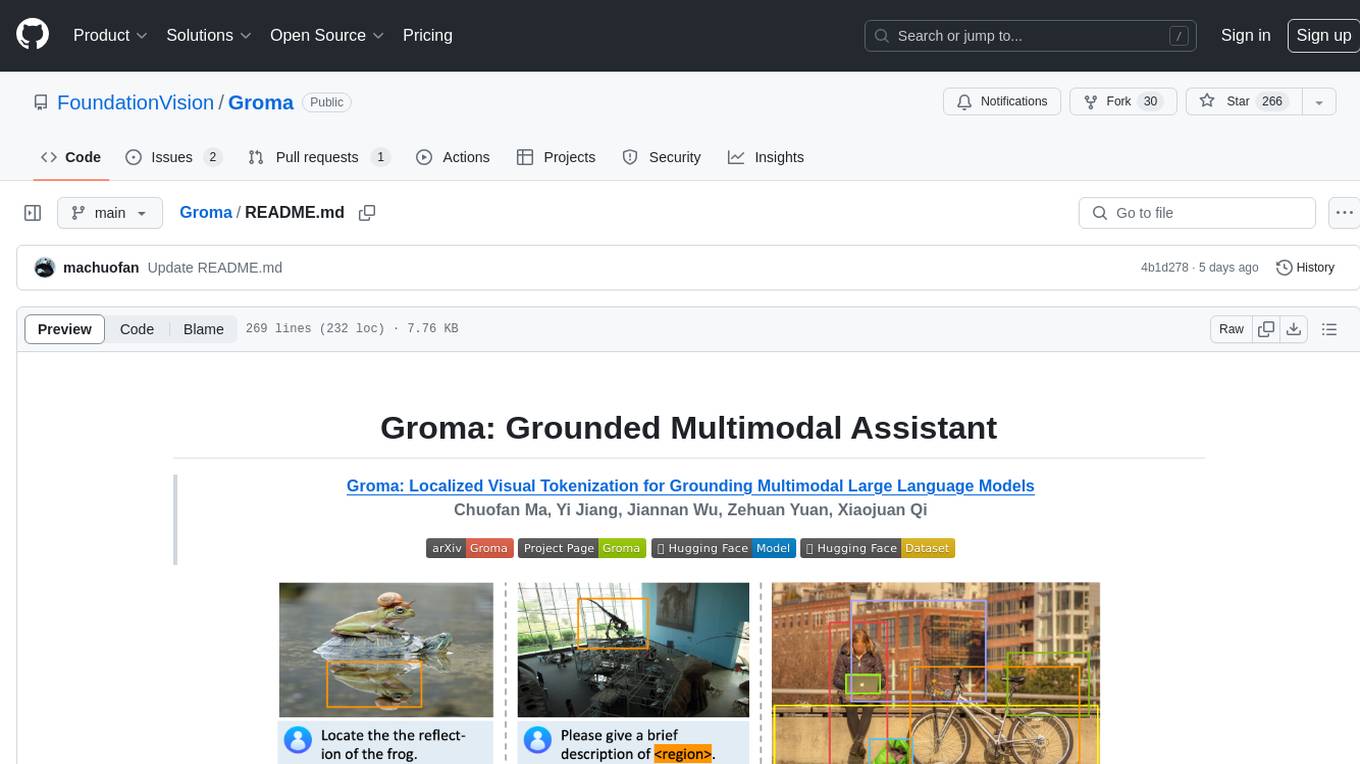
Groma
Groma is a grounded multimodal assistant that excels in region understanding and visual grounding. It can process user-defined region inputs and generate contextually grounded long-form responses. The tool presents a unique paradigm for multimodal large language models, focusing on visual tokenization for localization. Groma achieves state-of-the-art performance in referring expression comprehension benchmarks. The tool provides pretrained model weights and instructions for data preparation, training, inference, and evaluation. Users can customize training by starting from intermediate checkpoints. Groma is designed to handle tasks related to detection pretraining, alignment pretraining, instruction finetuning, instruction following, and more.
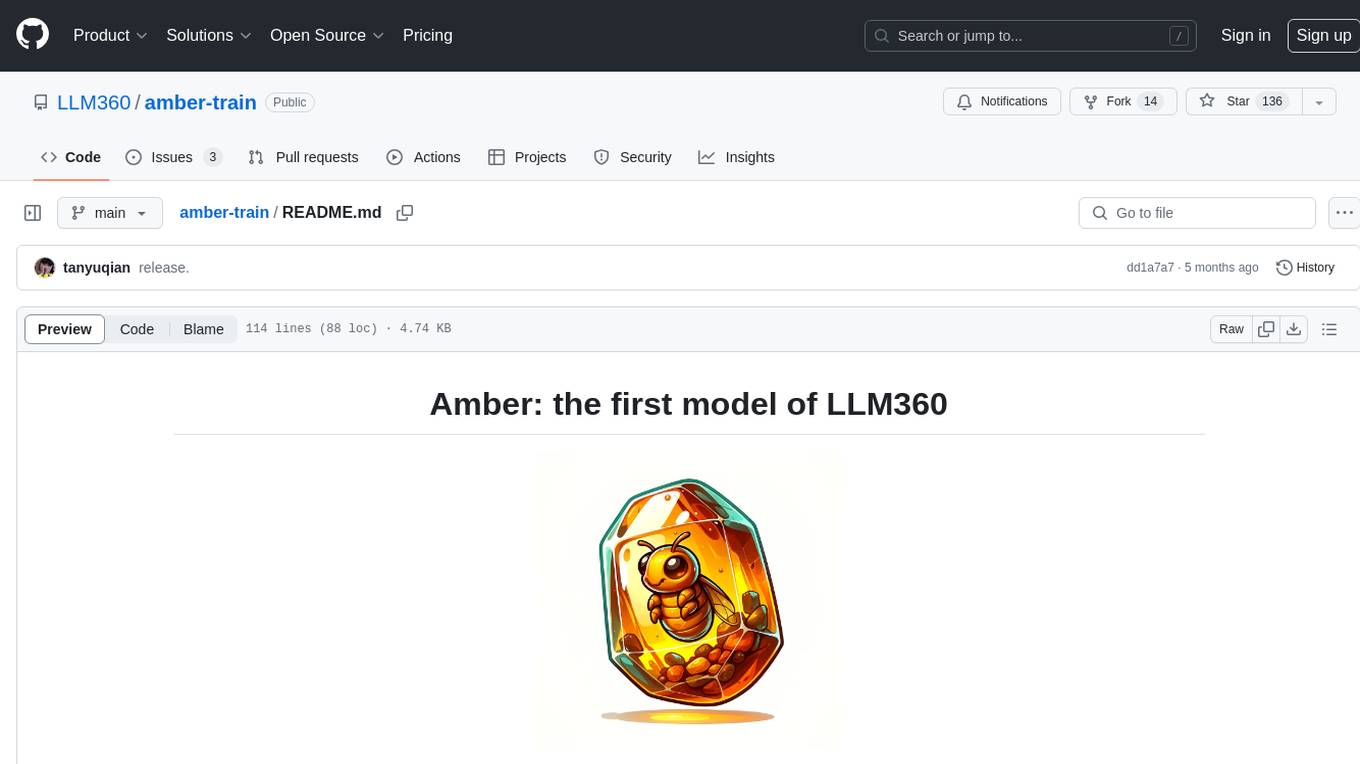
amber-train
Amber is the first model in the LLM360 family, an initiative for comprehensive and fully open-sourced LLMs. It is a 7B English language model with the LLaMA architecture. The model type is a language model with the same architecture as LLaMA-7B. It is licensed under Apache 2.0. The resources available include training code, data preparation, metrics, and fully processed Amber pretraining data. The model has been trained on various datasets like Arxiv, Book, C4, Refined-Web, StarCoder, StackExchange, and Wikipedia. The hyperparameters include a total of 6.7B parameters, hidden size of 4096, intermediate size of 11008, 32 attention heads, 32 hidden layers, RMSNorm ε of 1e^-6, max sequence length of 2048, and a vocabulary size of 32000.
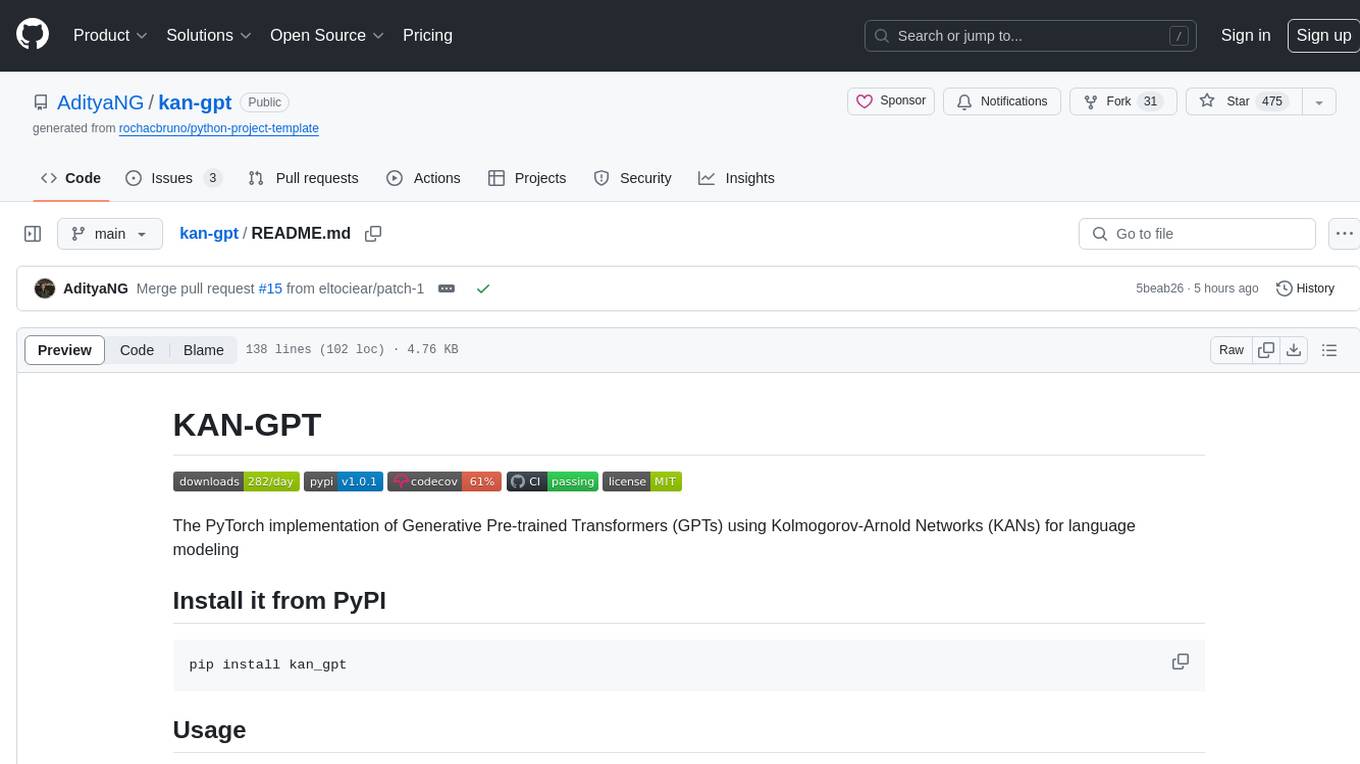
kan-gpt
The KAN-GPT repository is a PyTorch implementation of Generative Pre-trained Transformers (GPTs) using Kolmogorov-Arnold Networks (KANs) for language modeling. It provides a model for generating text based on prompts, with a focus on improving performance compared to traditional MLP-GPT models. The repository includes scripts for training the model, downloading datasets, and evaluating model performance. Development tasks include integrating with other libraries, testing, and documentation.
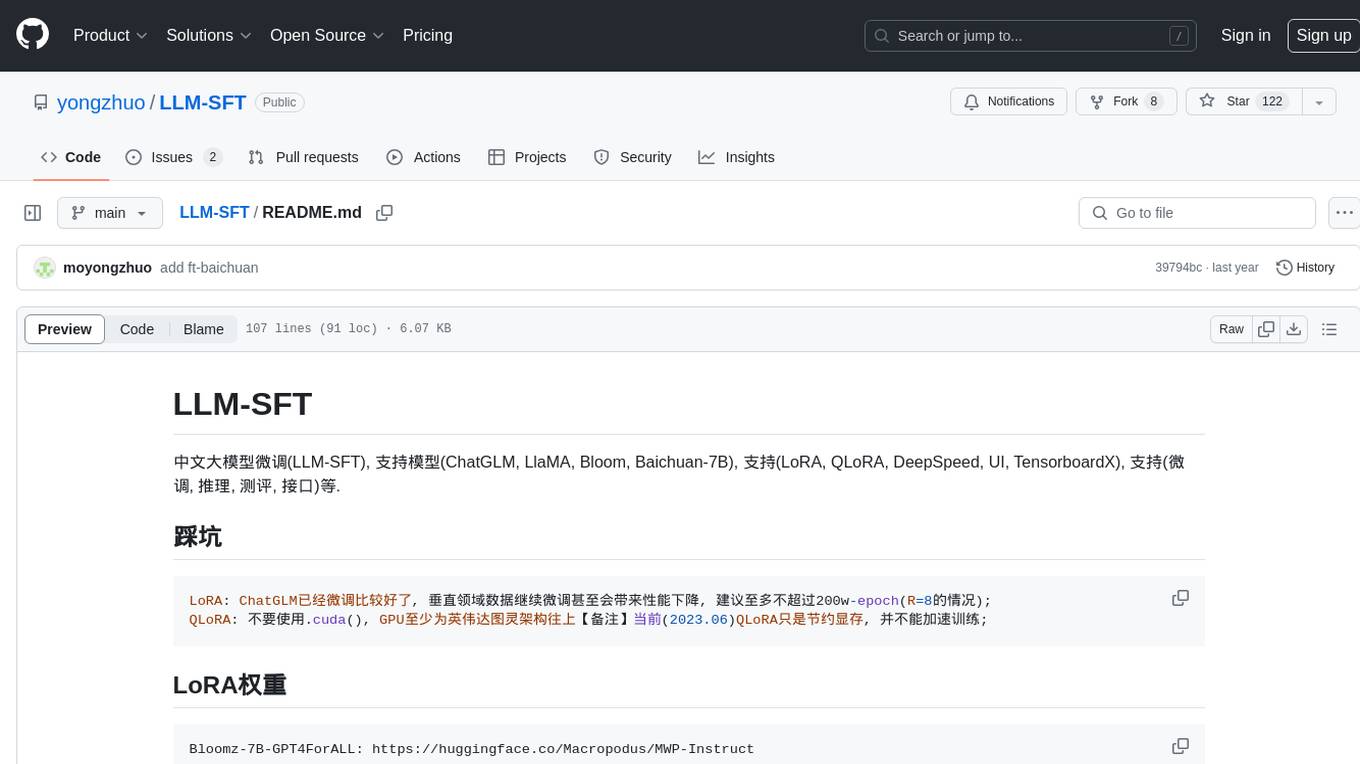
LLM-SFT
LLM-SFT is a Chinese large model fine-tuning tool that supports models such as ChatGLM, LlaMA, Bloom, Baichuan-7B, and frameworks like LoRA, QLoRA, DeepSpeed, UI, and TensorboardX. It facilitates tasks like fine-tuning, inference, evaluation, and API integration. The tool provides pre-trained weights for various models and datasets for Chinese language processing. It requires specific versions of libraries like transformers and torch for different functionalities.
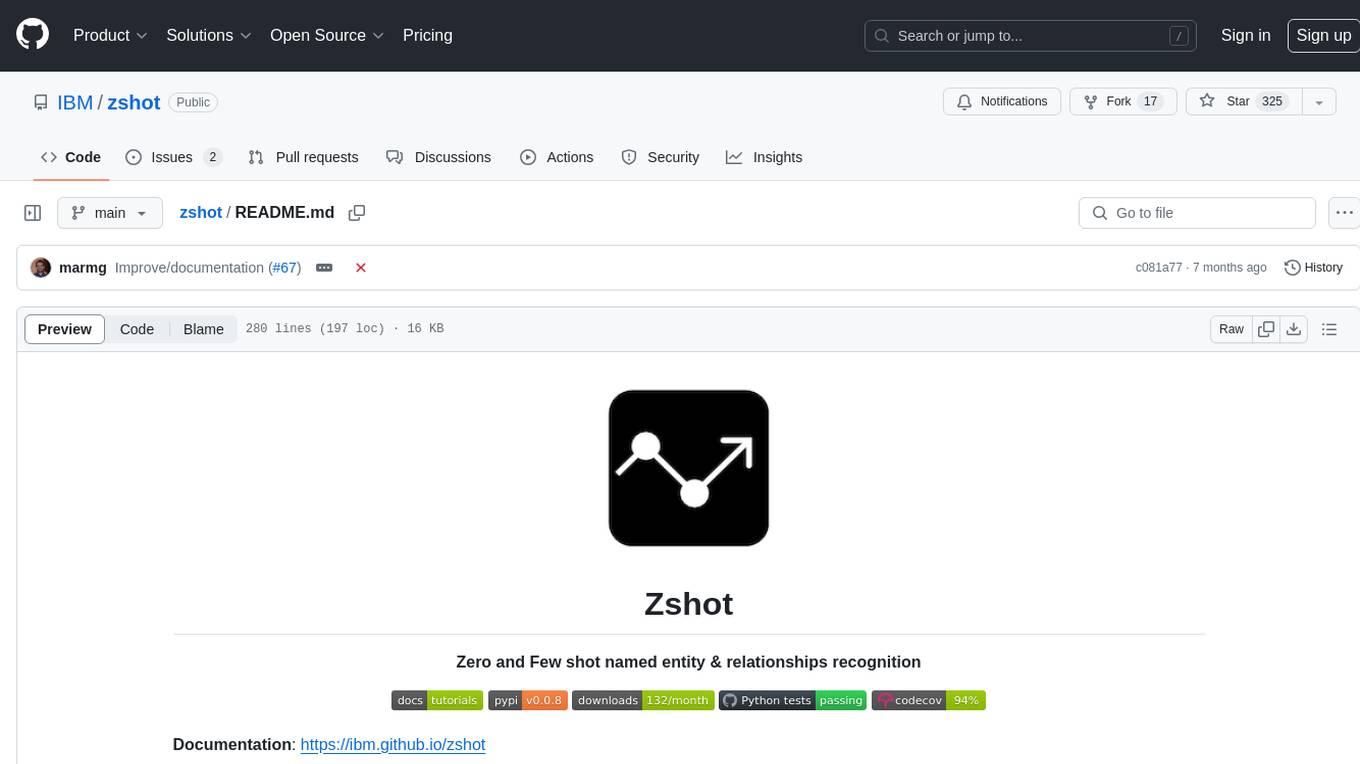
zshot
Zshot is a highly customizable framework for performing Zero and Few shot named entity and relationships recognition. It can be used for mentions extraction, wikification, zero and few shot named entity recognition, zero and few shot named relationship recognition, and visualization of zero-shot NER and RE extraction. The framework consists of two main components: the mentions extractor and the linker. There are multiple mentions extractors and linkers available, each serving a specific purpose. Zshot also includes a relations extractor and a knowledge extractor for extracting relations among entities and performing entity classification. The tool requires Python 3.6+ and dependencies like spacy, torch, transformers, evaluate, and datasets for evaluation over datasets like OntoNotes. Optional dependencies include flair and blink for additional functionalities. Zshot provides examples, tutorials, and evaluation methods to assess the performance of the components.
For similar jobs

weave
Weave is a toolkit for developing Generative AI applications, built by Weights & Biases. With Weave, you can log and debug language model inputs, outputs, and traces; build rigorous, apples-to-apples evaluations for language model use cases; and organize all the information generated across the LLM workflow, from experimentation to evaluations to production. Weave aims to bring rigor, best-practices, and composability to the inherently experimental process of developing Generative AI software, without introducing cognitive overhead.

LLMStack
LLMStack is a no-code platform for building generative AI agents, workflows, and chatbots. It allows users to connect their own data, internal tools, and GPT-powered models without any coding experience. LLMStack can be deployed to the cloud or on-premise and can be accessed via HTTP API or triggered from Slack or Discord.

VisionCraft
The VisionCraft API is a free API for using over 100 different AI models. From images to sound.

kaito
Kaito is an operator that automates the AI/ML inference model deployment in a Kubernetes cluster. It manages large model files using container images, avoids tuning deployment parameters to fit GPU hardware by providing preset configurations, auto-provisions GPU nodes based on model requirements, and hosts large model images in the public Microsoft Container Registry (MCR) if the license allows. Using Kaito, the workflow of onboarding large AI inference models in Kubernetes is largely simplified.

PyRIT
PyRIT is an open access automation framework designed to empower security professionals and ML engineers to red team foundation models and their applications. It automates AI Red Teaming tasks to allow operators to focus on more complicated and time-consuming tasks and can also identify security harms such as misuse (e.g., malware generation, jailbreaking), and privacy harms (e.g., identity theft). The goal is to allow researchers to have a baseline of how well their model and entire inference pipeline is doing against different harm categories and to be able to compare that baseline to future iterations of their model. This allows them to have empirical data on how well their model is doing today, and detect any degradation of performance based on future improvements.

tabby
Tabby is a self-hosted AI coding assistant, offering an open-source and on-premises alternative to GitHub Copilot. It boasts several key features: * Self-contained, with no need for a DBMS or cloud service. * OpenAPI interface, easy to integrate with existing infrastructure (e.g Cloud IDE). * Supports consumer-grade GPUs.

spear
SPEAR (Simulator for Photorealistic Embodied AI Research) is a powerful tool for training embodied agents. It features 300 unique virtual indoor environments with 2,566 unique rooms and 17,234 unique objects that can be manipulated individually. Each environment is designed by a professional artist and features detailed geometry, photorealistic materials, and a unique floor plan and object layout. SPEAR is implemented as Unreal Engine assets and provides an OpenAI Gym interface for interacting with the environments via Python.

Magick
Magick is a groundbreaking visual AIDE (Artificial Intelligence Development Environment) for no-code data pipelines and multimodal agents. Magick can connect to other services and comes with nodes and templates well-suited for intelligent agents, chatbots, complex reasoning systems and realistic characters.